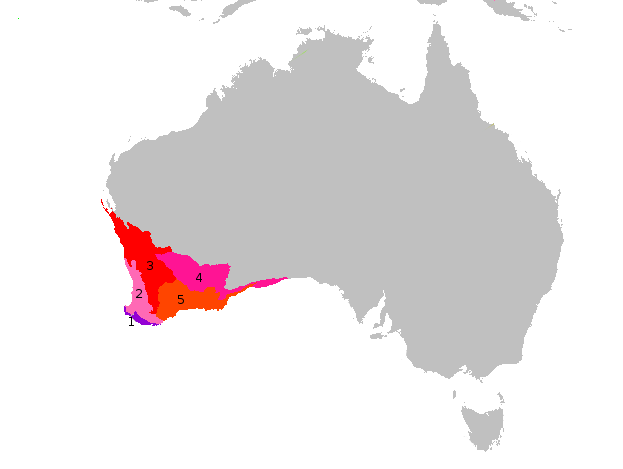|
Hakea Prostrata
''Hakea prostrata'', commonly known as harsh hakea, is a species of shrub that is endemic to the south-west of Western Australia. It is a low-lying shrub with prickly leaves and groups of white or cream-coloured flowers in late winter and early spring. Description ''Hakea prostrata'' is a shrub which grows to between in height with spreading branchlets. The oblong-obovate stem-clasping leaves have prickly edges and a central vein. Plentiful sweetly scented white or cream flowers are produced in axillary racemose inflorescences between July and October in its native range. Taxonomy and naming ''Hakea prostrata'' was first formally described in 1810 by botanist Robert Brown and published the description in ''Transactions of the Linnean Society of London''. The specific epithet (''prostrata'') is a Latin word meaning "down flat", "overthrown" or "laid low", referring to the low growing, coastal form of this plant. Distribution and habitat Harsh hakea is found from Geraldton ... [...More Info...] [...Related Items...] OR: [Wikipedia] [Google] [Baidu] |
Australasian Virtual Herbarium
The ''Australasian Virtual Herbarium'' (AVH) is an online resource that allows access to plant specimen data held by various Australian and New Zealand herbaria. It is part of the Atlas of Living Australia (ALA), and was formed by the amalgamation of ''Australia's Virtual Herbarium'' and ''NZ Virtual Herbarium''. As of 12 August 2014, more than five million specimens of the 8 million and upwards specimens available from participating institutions have been databased. Uses This resource is used by academics, students, and anyone interested in research in botany in Australia or New Zealand, since each record tells all that is known about the specimen: where and when it was collected; by whom; its current identification together with the botanist who identified it; and information on habitat and associated species. ALA post processes the original herbarium data, giving further fields with respect to taxonomy and quality of the data. When interrogating individual specimen reco ... [...More Info...] [...Related Items...] OR: [Wikipedia] [Google] [Baidu] |
Endemism
Endemism is the state of a species being found only in a single defined geographic location, such as an island, state, nation, country or other defined zone; organisms that are indigenous to a place are not endemic to it if they are also found elsewhere. For example, the Cape sugarbird is found exclusively in southwestern South Africa and is therefore said to be ''endemic'' to that particular part of the world. An endemic species can also be referred to as an ''endemism'' or, in scientific literature, as an ''endemite''. Similarly, many species found in the Western ghats of India are examples of endemism. Endemism is an important concept in conservation biology for measuring biodiversity in a particular place and evaluating the risk of extinction for species. Endemism is also of interest in evolutionary biology, because it provides clues about how changes in the environment cause species to undergo range shifts (potentially expanding their range into a larger area or b ... [...More Info...] [...Related Items...] OR: [Wikipedia] [Google] [Baidu] |
Southwest Australia
Southwest Australia is a biogeographic region in Western Australia. It includes the Mediterranean-climate area of southwestern Australia, which is home to a diverse and distinctive flora and fauna. The region is also known as the Southwest Australia Global Diversity Hotspot. Geography The region includes the Mediterranean forests, woodlands, and scrub ecoregions of Western Australia. The region covers 356,717 km2, consisting of a broad coastal plain 20–120 kilometres wide, transitioning to gently undulating uplands made up of weathered granite, gneiss and laterite. Bluff Knoll in the Stirling Range is the highest peak in the region, at 1,099 metres (3,606 ft) elevation. Desert and xeric shrublands lie to the north and east across the centre of Australia, separating Southwest Australia from the other Mediterranean and humid-climate regions of the continent. Climate The region has a wet-winter, dry-summer Mediterranean climate, one of five such regions in the worl ... [...More Info...] [...Related Items...] OR: [Wikipedia] [Google] [Baidu] |
Western Australia
Western Australia (WA) is the westernmost state of Australia. It is bounded by the Indian Ocean to the north and west, the Southern Ocean to the south, the Northern Territory to the north-east, and South Australia to the south-east. Western Australia is Australia's largest state, with a land area of , and is also the List of country subdivisions by area, second-largest subdivision of any country on Earth. Western Australia has a diverse range of climates, including tropical conditions in the Kimberley (Western Australia), Kimberley, deserts in the interior (including the Great Sandy Desert, Little Sandy Desert, Gibson Desert, and Great Victoria Desert) and a Mediterranean climate on the south-west and southern coastal areas. the state has 2.965 million inhabitants—10.9 percent of the national total. Over 90 percent of the state's population live in the South-West Land Division, south-west corner and around 80 percent live in the state capital Perth, leaving the remainder ... [...More Info...] [...Related Items...] OR: [Wikipedia] [Google] [Baidu] |
Hakea Prostrata Habit
''Hakea'' ( ) is a genus of about 150 species of flowering plants in the family ''Proteaceae'', endemic to Australia. They are shrubs or small trees with leaves that are sometimes flat, otherwise circular in cross section in which case they are sometimes divided. The flowers are usually arranged in groups in leaf axils and resemble those of other genera, especially ''Grevillea''. Hakeas have woody fruit which distinguishes them from grevilleas which have non-woody fruit which release the seeds as they mature. Hakeas are found in every state of Australia with the highest species diversity being found in the south west of Western Australia. Description Plants in the genus ''Hakea'' are shrubs or small trees. Some species have flat leaves, whilst others have leaves which are needle-like, in which case they are sometimes divided and sometimes have a groove on the lower surface. The flowers are arranged in groups in leaf axils and are surrounded by bracts when in bud. The flowers have ... [...More Info...] [...Related Items...] OR: [Wikipedia] [Google] [Baidu] |




